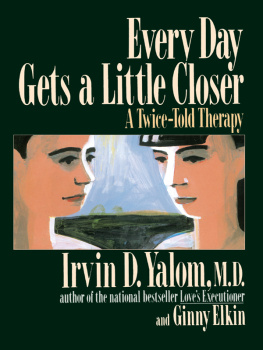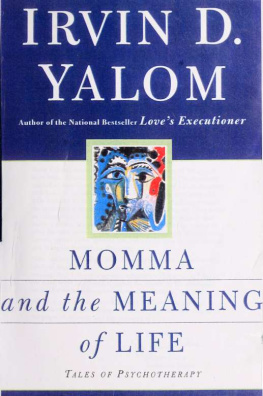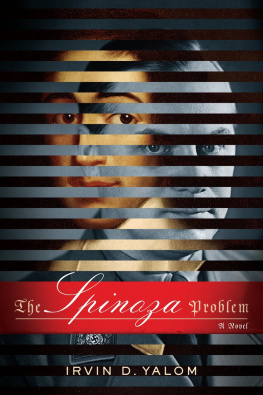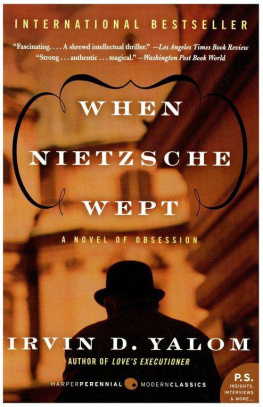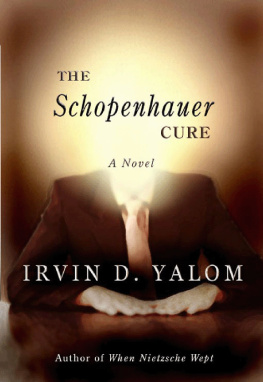Editors Foreword
IT IS TRUE that the literature of psychotherapy already numbers many works which recount the saga of recovery. Since the turn of the century, psychiatrists have increasingly elected to publish illustrative and exceptional case histories, and, not to be outdone, patients have increasingly presented their own retrospective versions. This book is unique in that it simultaneously traces the course of treatment from the vantage points of both patient and doctor, as they evolve a delicate and difficult relationship which has personal meaning for both of them.
The book is an outgrowth of an experiment undertaken by my husband, Dr. Irvin Yalom of Stanford University, and one of his patients, henceforth known as Ginny. In the fall of 1970 my husband decided that it would be inadvisable for Ginny to continue with him and a co-therapist in group therapy, since she had made virtually no progress in that format for a year and a half, and he suggested that they subsequently meet in individual therapy. Because Ginnys problems included that of a writers block (a serious complaint for an aspiring novelist), Dr. Yalom stipulated that she pay for treatment in the form of post-session reports, which would provide an obvious stimulus to her writing. At the same time Dr. Yalom decided that he too would prepare a separate account of their weekly meetings, with the understanding that he and Ginny would exchange these reports at six months intervals, in the hope of therapeutic benefit. For two years thereafter doctor and patient recorded his and her recollections of the hour they had shared together, frequently adding afterthoughts, interpretations, emotions and associations which hadnt been voiced during the session.
Although my husband almost never discusses his patients with me, I was privy to some of his reflections on Ginny as he considered this method of encouraging her writing. Since I am a professor of literature, he knew this project would be of real interest to me. I suggested that he carefully preserve both sets of reports until the end of therapy and then decide whether they merited a wider audience. Privately I wondered if the post-session reports might not constitute a publishable piece of literature, with two distinct characters and two recognizable literary styles, not unlike an epistolary novel.
It was, thus, with an especial interest that I read the manuscript for the first time two years later. My enthusiastic evaluation, and that of less biased judges, succeeded in persuading the authors to publish it. Although changes were necessary to conceal the identity of the patient and to adapt the doctors tapescripts for a reading public, the words are essentially those of the original texts. No supplemental thoughts or fictive events have been added to the symbiotic drama of psychotherapy. In the case of the doctors accounts, not one significant reflection has been added or omittedexcept for a few tapes which were, unfortunately, mislaid and lost for good. Aside from very minor stylistic corrections, Ginnys reports are virtually unaltered.
At the suggestion of several readers who found the manuscript difficult to approach without some explanatory material, and others who were eager to know what became of Ginny after therapy, Dr. Yalom and Ginny each wrote a Foreword and an Afterword composed a year and a half after their last therapeutic meeting together. These do add considerable information and clarification of both a personal and theoretical nature. Still, it is my belief that the central portion can be read like a novel, as the story of two human beings who met in the intimacy of the psychiatric tte--tte and now permit you to know them as they knew each other.
Marilyn Yalom
February 20, 1974
Doctor Yaloms Foreword
IT ALWAYS wrenches me to find old appointment books filled with the half forgotten names of patients with whom I have had the most tender experiences. So many people, so many fine moments. What has happened to them? My many-tiered file cabinets, my mounds of tape recordings often remind me of some vast cemetery: lives pressed into clinical folders, voices trapped on electromagnetic bands mutely and eternally playing out their dramas. Living with these monuments imbues me with a keen sense of transience. Even as I find myself immersed in the present I sense the specter of decay watching and waitinga decay which will ultimately vanquish lived experience and yet, by its very inexorability, bestows a poignancy and beauty. The desire to relate my experience with Ginny is a very compelling one; I am intrigued by the opportunity to stave off decay, to prolong the span of our brief life together. How much better to know that it will exist in the mind of the reader rather than in the abandoned warehouse of unread clinical notes and unheard electromagnetic tapes.
The story begins with a phone call. A thready voice told me that her name was Ginny, that she had just arrived in California, that she had been in therapy for several months with a colleague of mine in the East who had referred her to me. Having recently returned from a years sabbatical in London, I had still much free time and scheduled a meeting with Ginny two days later.
I met her in the waiting room and ushered her down the hall into my office. I could not walk slowly enough; like an Oriental wife she followed a few noiseless steps behind. She did not belong to herself, nothing went with anything elseher hair, her grin, her voice, her walk, her sweater, her shoes, everything had been flung together by chance, and there was the immediate possibility of allhair, walk, limbs, tattered jeans, G.I. socks, everythingflying asunder. Leaving what? I wondered. Perhaps just the grin. Not pretty, no matter how one arranged the parts! Yet curiously appealing. Somehow, in only minutes, she managed to let me know that I could do everything and that she completely delivered herself up into my hands. I did not mind. At the time it did not seem a heavy burden.
She spoke, and I learned that she was twenty-three years old, the daughter of a one-time opera singer and a Philadelphia businessman. She had a sister four years younger and a gift for creative writing. She had come to California because she had been accepted, on the basis of some short stories, into a one-year creative writing program at a nearby college.
Why was she now seeking help? She said that she needed to continue the therapy she had begun last year, and, in a confusing unsystematic fashion, gradually recounted her major difficulties in living. In addition to her explicit complaints, I recognized during the course of the interview several other major problem areas.
First, her self-portraitrelated quickly and breathlessly with occasional fetching metaphors punctuating the litany of self-hatred. She is masochistic in all things. All her life she has neglected her own needs and pleasures. She has no respect for herself. She feels she is a disembodied spirita chirping canary hopping back and forth from shoulder to shoulder, as she and her friends walk down the street. She imagines that only as an ethereal wisp is she of interest to others.

